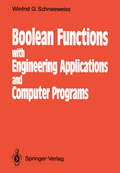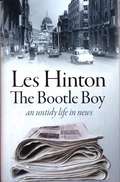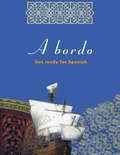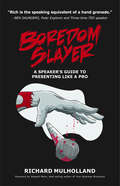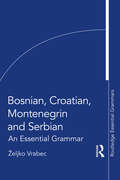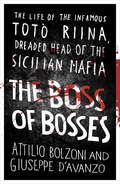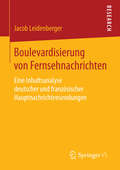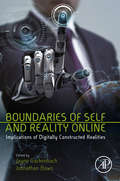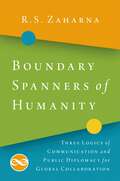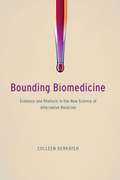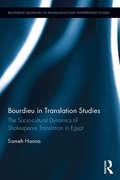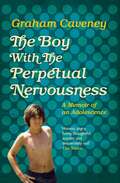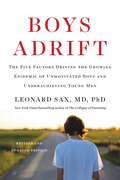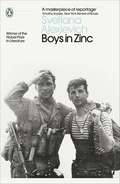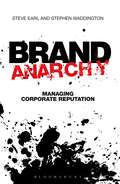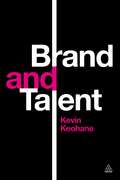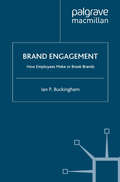- Table View
- List View
Boolean Functions: With Engineering Applications and Computer Programs
by Winfried G. SchneeweissModern systems engineering (e. g. switching circuits design) and operations research (e. g. reliability systems theory) use Boolean functions with increasing regularity. For practitioners and students in these fields books written for mathe maticians are in several respects not the best source of easy to use information, and standard books, such as, on switching circuits theory and reliability theory, are mostly somewhat narrow as far as Boolean analysis is concerned. Further more, in books on switching circuits theory the relevant stochastic theory is not covered. Aspects of the probabilistic theory of Boolean functions are treated in some works on reliability theory, but the results deserve a much broader interpre tation. Just as the applied theory (e. g. of the Laplace transform) is useful in control theory, renewal theory, queueing theory, etc. , the applied theory of Boolean functions (of indicator variables) can be useful in reliability theory, switching circuits theory, digital diagnostics and communications theory. This book is aimed at providing a sufficiently deep understanding of useful results both in practical work and in applied research. Boolean variables are restricted here to indicator or O/l variables, i. e. variables whose values, namely 0 and 1, are not free for a wide range of interpretations, e. g. in digital electronics 0 for L ==low voltage and 1 for H == high voltage.
The Bootle Boy: An Untidy Life In News
by Les HintonWhen Les Hinton first fulfils his schoolboy dream of working on Fleet Street, it is still a place awash in warm beer, black ink, fag ash, and hot metal. Fifty-two years after being sent out to buy a sandwich for his first boss, one Rupert Murdoch, when Les finally leaves Murdoch’s employment in 2011, the business of news has been turned upside down, in a tumble of social and technological change. Les Hinton has been present at and noiselessly directed several key scenes in that tale of revolutionary transformation, as employee and later head of Murdoch companies in newspapers, magazines, and television, on three continents over five decades, in Wapping and Wall Street, Australia and California. Born amid the rubble of the blitzed docklands of Bootle, and schooled by an itinerant Army childhood, he came to the centre from the periphery, just as Murdoch did. There, with a gang of like-minded outsiders, he set about redrawing the map of the media. Hinton depicts the upheavals that swept his trade with the same widescreen perspective and sharp colours he deploys to show us how politicians from Clinton to Blair, from Brown to Cameron, alternately canoodled and raged inside their arranged media marriages. We see the death of Diana, the IRA bombings, the charisma of Bill Clinton, and the phone-hacking scandal from a revelatory new angle. And we get the most undeluded and undiluted portrait yet of the man who is perhaps the last of the great press barons. Above all, emerging out of Hinton's scintillating stories of half a century of Murdoch and news revolutions, comes the voice of a wandering Liverpudlian who is still in love with the life of a newspaperman, and now the author of one of the defining media memoirs of our age.
A Bordo: Get Ready for Spanish
by Spanish Course TeamIdeal for near beginners, A bordo takes learners up to the equivalent of GCSE level Spanish. The course is accompanied by three audio-cassettes which include drama and dialogue. Features include:* focus on both Spanish and Latin-American culture* emphasis on communicating in everyday situations* varied exercises, with answer key and progress resumé at the end of each unit.A bordo is the preparatory course for En rumbo, also devised by the Open University Spanish team (see below).
A Bordo: Get Ready for Spanish
by Spanish Course TeamIdeal for near beginners, A bordo takes learners up to the equivalent of GCSE level Spanish. The course is accompanied by three audio-cassettes which include drama and dialogue. Features include:* focus on both Spanish and Latin-American culture* emphasis on communicating in everyday situations* varied exercises, with answer key and progress resumé at the end of each unit.A bordo is the preparatory course for En rumbo, also devised by the Open University Spanish team (see below).
Boredom Slayer: A speaker’s guide to presenting like a pro
by Richard MulhollandAny fool can put together a presentation; this book exists because so many do.There’s something sucking the life out of audiences everywhere, transforming them from the very people who can change your business into the disengaged masses. It’s called The Boredom … and your job is to slay it!It’s time to fight back.It’s time to save the world ...... one bored audience at a time.Whether you’re a seasoned public speaker, or getting ready for your first company presentation, this candid and practical guide by renowned global speaker and presentation coach Richard Mulholland will give you key insights.Grabbing and keeping an audience’s attention.Structuring talks that command fees and change companies.Dispelling the myths around public speaking that are getting in the way of that standing ovation.Speaking like a true leader.Richard Mulholland is the co-founder of global presentation powerhouses Missing Link and TalkDrawer. He is a renowned speaker and has presented his thinking in many countries including Canada, Puerto Rico, UK, USA, Germany, Kenya, and Pakistan. When not activating his audiences he can be found coaching many top CEOs and TED speakers to activate theirs.
Bosnian, Croatian, Montenegrin and Serbian: An Essential Grammar (Routledge Essential Grammars)
by Željko VrabecBosnian, Croatian, Montenegrin and Serbian: An Essential Grammar is intended for beginners and intermediate students who need a reference that explains grammar in straightforward terms. It covers all the main areas of the modern single BCMS grammatical system in an accessible way, and free from jargon. When linguistic terminology is used, it is explained in layman’s terms, the logic of a rule is presented simply and near parallels are drawn with English. This book covers all the grammar necessary for everyday communication (reaching B1 and B2 of the CEFR, ACTFL Intermediate-Intermediate- Mid). The book comprises of extensive chapters on all parts of speech, the creation of different word forms (endings for cases in nouns and adjectives, case forms for pronouns, tenses, verbal modes, verbal aspect etc.) and their uses in sentences. Each rule is illustrated with numerous examples from everyday living language used in Bosnia-Herzegovina, Croatia, Montenegro and Serbia. It is a unique reference book in English aimed at this level of language study that treats BCMS as a single grammar system, explaining and highlighting all the small differences between the four variants of this polycentric language.
Bosnian, Croatian, Montenegrin and Serbian: An Essential Grammar (Routledge Essential Grammars)
by Željko VrabecBosnian, Croatian, Montenegrin and Serbian: An Essential Grammar is intended for beginners and intermediate students who need a reference that explains grammar in straightforward terms. It covers all the main areas of the modern single BCMS grammatical system in an accessible way, and free from jargon. When linguistic terminology is used, it is explained in layman’s terms, the logic of a rule is presented simply and near parallels are drawn with English. This book covers all the grammar necessary for everyday communication (reaching B1 and B2 of the CEFR, ACTFL Intermediate-Intermediate- Mid). The book comprises of extensive chapters on all parts of speech, the creation of different word forms (endings for cases in nouns and adjectives, case forms for pronouns, tenses, verbal modes, verbal aspect etc.) and their uses in sentences. Each rule is illustrated with numerous examples from everyday living language used in Bosnia-Herzegovina, Croatia, Montenegro and Serbia. It is a unique reference book in English aimed at this level of language study that treats BCMS as a single grammar system, explaining and highlighting all the small differences between the four variants of this polycentric language.
The Boss of Bosses: The Life of the Infamous Toto Riina Dreaded Head of the Sicilian Mafia
by Giuseppe D'Avanzo Attilio BolzoniThis is the true story of Totò Riina, the Cosa Nostra boss who rose from nothing to become the most powerful man in Sicily. The picture emerges of a bloodthirsty, power-hungry monster who, despite his lowly beginnings, is able to outmanoeuvre the other Mafia chiefs and take control of the organisation. However, the story is not just that of Riina, but also of Sicily itself. D'Avanzo and Bolzoni have transformed a complex series of events spanning several decades into a gripping narrative.In prison for 18 years now, Totò Riina still remains the dictator of the Cosa Nostra. This book tells the haunting and disturbing tale, with thorough investigation and testimony of the Sicilian Corleone.
Boulevardisierung von Fernsehnachrichten: Eine Inhaltsanalyse deutscher und französischer Hauptnachrichtensendungen
by Jacob LeidenbergerJacob Leidenberger setzt sich mit dem Begriff der „Boulevardisierung“ auseinander und untersucht, ob sich deutsche und französische Fernsehnachrichten zwischen 1992 und 2010 hinsichtlich der behandelten Themen, des journalistischen Stils sowie im Hinblick auf die Präsentationsformen dem Boulevardformat angenähert haben. Mittels einer quantitativen Inhaltsanalyse von 125 Nachrichtensendungen und anhand mehrerer Experteninterviews mit Nachrichtenredakteuren prüft der Autor, ob in deutschen und französischen Abendnachrichten eine Boulevardisierung stattgefunden und diese im Lauf der Zeit an Bedeutung gewonnen hat. Gerade wegen der geringen Anzahl einschlägiger Studien in beiden Ländern trägt er dazu bei, ein wenig Licht ins „Boulevardisierungs-Dunkel“ zu bringen.
Boundaries of Self and Reality Online: Implications of Digitally Constructed Realities
by Jayne Gackenbach Johnathan BownAs technology continues to rapidly advance, individuals and society are profoundly changed. So too are the tools used to measure this universe and, therefore, our understanding of reality improves. Boundaries of Self and Reality Online examines the idea that technological advances associated with the Internet are moving us in multiple domains toward various "edges." These edges range from self, to society, to relationships, and even to the very nature of reality. Boundaries are dissolving and we are redefining the elements of identity. The book begins with explorations of the digitally constructed self and the relationship between the individual and technological reality. Then, the focus shifts to society at large and includes a contribution from Chinese researchers about the isolated Chinese Internet. The later chapters of the book explore digital reality at large, including discussions on virtual reality, Web consciousness, and digital physics.Cyberpsychology architectureVideo games as a tool for self-understandingAvatars and the meaning behind themGame transfer phenomenaA Jungian perspective on technologyPolitics of social mediaThe history and science of video game playTranscendent virtual reality experiencesThe theophoric quality of video games
Boundary Spanners of Humanity: Three Logics of Communications and Public Diplomacy for Global Collaboration
by R.S. ZaharnaWritten by a leading scholar of public diplomacy, Boundary Spanners of Humanity introduces a pan-human vision of communication that can revolutionize how we collaborate to solve global problems. Never before has humanity enjoyed better technological capabilities for interconnection than today. Ironically, rather than benefiting from the global pool of human resources and intellectual wealth to solve shared problems, nations are experiencing public discord and global divisions. Boundary Spanners of Humanity tackles the challenge of how to enhance global collaboration by introducing three pan-human logics of human communication and public diplomacy that can transform how we view diversity in an interconnected world. R.S. Zaharna begins by asking why the very tools needed for global collaboration-communication and public diplomacy-are undermining our efforts to work together. Her research reveals how contemporary communication is based on a nineteenth-century mindset of separateness that divided people into mutually exclusive cultural and national categories. That mindset reinforces human divisions and erodes global collaboration. In a radical break from conventional models, Zaharna introduces a vision of humanity-centered public diplomacy featuring three complementary logics of communication. Zaharna's innovative approach stems from decade-long, interdisciplinary research that spans from ancient cosmologies to emerging neurobiology. She draws on a rich array of global examples from ancient and indigenous precolonial diplomacies to spontaneous online communication during the Covid-19 pandemic to provide insights into overlooked aspects of emotion, empathy, spirituality, and synchrony in how nations and people communicate in the global arena. Ambitiously conceived, this book will bring a new, global understanding of how to conduct public diplomacy for the world's boundary spanners-those who would find commonality among our many divisions-and collaborate on humanity's shared global problems.
Boundary Spanners of Humanity: Three Logics of Communications and Public Diplomacy for Global Collaboration
by R.S. ZaharnaWritten by a leading scholar of public diplomacy, Boundary Spanners of Humanity introduces a pan-human vision of communication that can revolutionize how we collaborate to solve global problems. Never before has humanity enjoyed better technological capabilities for interconnection than today. Ironically, rather than benefiting from the global pool of human resources and intellectual wealth to solve shared problems, nations are experiencing public discord and global divisions. Boundary Spanners of Humanity tackles the challenge of how to enhance global collaboration by introducing three pan-human logics of human communication and public diplomacy that can transform how we view diversity in an interconnected world. R.S. Zaharna begins by asking why the very tools needed for global collaboration-communication and public diplomacy-are undermining our efforts to work together. Her research reveals how contemporary communication is based on a nineteenth-century mindset of separateness that divided people into mutually exclusive cultural and national categories. That mindset reinforces human divisions and erodes global collaboration. In a radical break from conventional models, Zaharna introduces a vision of humanity-centered public diplomacy featuring three complementary logics of communication. Zaharna's innovative approach stems from decade-long, interdisciplinary research that spans from ancient cosmologies to emerging neurobiology. She draws on a rich array of global examples from ancient and indigenous precolonial diplomacies to spontaneous online communication during the Covid-19 pandemic to provide insights into overlooked aspects of emotion, empathy, spirituality, and synchrony in how nations and people communicate in the global arena. Ambitiously conceived, this book will bring a new, global understanding of how to conduct public diplomacy for the world's boundary spanners-those who would find commonality among our many divisions-and collaborate on humanity's shared global problems.
Bounding Biomedicine: Evidence and Rhetoric in the New Science of Alternative Medicine
by Colleen DerkatchDuring the 1990s, an unprecedented number of Americans turned to complementary and alternative medicine (CAM), an umbrella term encompassing chiropractic, energy healing, herbal medicine, homeopathy, meditation, naturopathy, and traditional Chinese medicine. By 1997, nearly half the US population was seeking CAM, spending at least $27 billion out of pocket. Bounding Biomedicine centers on this boundary-changing era, looking at how consumer demand shook the health care hierarchy. Drawing on scholarship in rhetoric and science and technology studies, the book examines how the medical profession scrambled to maintain its position of privilege and prestige, even as its foothold appeared to be crumbling. Colleen Derkatch analyzes CAM-themed medical journals and related discourse to illustrate how members of the medical establishment applied Western standards of evaluation and peer review to test health practices that did not fit easily (or at all) within standard frameworks of medical research. And she shows that, despite many practitioners’ efforts to eliminate the boundaries between “regular” and “alternative,” this research on CAM and the forms of communication that surrounded it ultimately ended up creating an even greater division between what counts as safe, effective health care and what does not. At a time when debates over treatment choices have flared up again, Bounding Biomedicine gives us a possible blueprint for understanding how the medical establishment will react to this new era of therapeutic change.
Bounding Biomedicine: Evidence and Rhetoric in the New Science of Alternative Medicine
by Colleen DerkatchDuring the 1990s, an unprecedented number of Americans turned to complementary and alternative medicine (CAM), an umbrella term encompassing chiropractic, energy healing, herbal medicine, homeopathy, meditation, naturopathy, and traditional Chinese medicine. By 1997, nearly half the US population was seeking CAM, spending at least $27 billion out of pocket. Bounding Biomedicine centers on this boundary-changing era, looking at how consumer demand shook the health care hierarchy. Drawing on scholarship in rhetoric and science and technology studies, the book examines how the medical profession scrambled to maintain its position of privilege and prestige, even as its foothold appeared to be crumbling. Colleen Derkatch analyzes CAM-themed medical journals and related discourse to illustrate how members of the medical establishment applied Western standards of evaluation and peer review to test health practices that did not fit easily (or at all) within standard frameworks of medical research. And she shows that, despite many practitioners’ efforts to eliminate the boundaries between “regular” and “alternative,” this research on CAM and the forms of communication that surrounded it ultimately ended up creating an even greater division between what counts as safe, effective health care and what does not. At a time when debates over treatment choices have flared up again, Bounding Biomedicine gives us a possible blueprint for understanding how the medical establishment will react to this new era of therapeutic change.
Bounding Biomedicine: Evidence and Rhetoric in the New Science of Alternative Medicine
by Colleen DerkatchDuring the 1990s, an unprecedented number of Americans turned to complementary and alternative medicine (CAM), an umbrella term encompassing chiropractic, energy healing, herbal medicine, homeopathy, meditation, naturopathy, and traditional Chinese medicine. By 1997, nearly half the US population was seeking CAM, spending at least $27 billion out of pocket. Bounding Biomedicine centers on this boundary-changing era, looking at how consumer demand shook the health care hierarchy. Drawing on scholarship in rhetoric and science and technology studies, the book examines how the medical profession scrambled to maintain its position of privilege and prestige, even as its foothold appeared to be crumbling. Colleen Derkatch analyzes CAM-themed medical journals and related discourse to illustrate how members of the medical establishment applied Western standards of evaluation and peer review to test health practices that did not fit easily (or at all) within standard frameworks of medical research. And she shows that, despite many practitioners’ efforts to eliminate the boundaries between “regular” and “alternative,” this research on CAM and the forms of communication that surrounded it ultimately ended up creating an even greater division between what counts as safe, effective health care and what does not. At a time when debates over treatment choices have flared up again, Bounding Biomedicine gives us a possible blueprint for understanding how the medical establishment will react to this new era of therapeutic change.
Bounding Biomedicine: Evidence and Rhetoric in the New Science of Alternative Medicine
by Colleen DerkatchDuring the 1990s, an unprecedented number of Americans turned to complementary and alternative medicine (CAM), an umbrella term encompassing chiropractic, energy healing, herbal medicine, homeopathy, meditation, naturopathy, and traditional Chinese medicine. By 1997, nearly half the US population was seeking CAM, spending at least $27 billion out of pocket. Bounding Biomedicine centers on this boundary-changing era, looking at how consumer demand shook the health care hierarchy. Drawing on scholarship in rhetoric and science and technology studies, the book examines how the medical profession scrambled to maintain its position of privilege and prestige, even as its foothold appeared to be crumbling. Colleen Derkatch analyzes CAM-themed medical journals and related discourse to illustrate how members of the medical establishment applied Western standards of evaluation and peer review to test health practices that did not fit easily (or at all) within standard frameworks of medical research. And she shows that, despite many practitioners’ efforts to eliminate the boundaries between “regular” and “alternative,” this research on CAM and the forms of communication that surrounded it ultimately ended up creating an even greater division between what counts as safe, effective health care and what does not. At a time when debates over treatment choices have flared up again, Bounding Biomedicine gives us a possible blueprint for understanding how the medical establishment will react to this new era of therapeutic change.
Bourdieu in Translation Studies: The Socio-cultural Dynamics of Shakespeare Translation in Egypt (Routledge Advances in Translation and Interpreting Studies)
by Sameh HannaThis book explores the implications of Pierre Bourdieu’s sociology of cultural production for the study of translation as a socio-cultural activity. Bourdieu’s work has continued to inspire research on translation in the last few years, though without a detailed, large-scale investigation that tests the viability of his conceptual tools and methodological assumptions. With focus on the Arabic translations of Shakespeare’s tragedies in Egypt, this book offers a detailed analysis of the theory of ‘fields of cultural production’ with the purpose of providing a fresh perspective on the genesis and development of drama translation in Arabic. The different cases of the Arabic translations of Hamlet, Macbeth, King Lear and Othello lend themselves to sociological analysis, due to the complex socio-cultural dynamics that conditioned the translation decisions made by translators, theatre directors, actors/actresses and publishers. In challenging the mainstream history of Shakespeare translation into Arabic, which is mainly premised on the linguistic proximity between source and target texts, this book attempts a ‘social history’ of the ‘Arabic Shakespeare’ which takes as its foundational assumption the fact that translation is a socially-situated phenomenon that is only fully appreciated in its socio-cultural milieu. Through a detailed discussion of the production, dissemination and consumption of the Arabic translations of Shakespeare’s tragedies, Bourdieu in Translation Studies marks a significant contribution to both sociology of translation and the cultural history of modern Egypt.
Bourdieu in Translation Studies: The Socio-cultural Dynamics of Shakespeare Translation in Egypt (Routledge Advances in Translation and Interpreting Studies)
by Sameh HannaThis book explores the implications of Pierre Bourdieu’s sociology of cultural production for the study of translation as a socio-cultural activity. Bourdieu’s work has continued to inspire research on translation in the last few years, though without a detailed, large-scale investigation that tests the viability of his conceptual tools and methodological assumptions. With focus on the Arabic translations of Shakespeare’s tragedies in Egypt, this book offers a detailed analysis of the theory of ‘fields of cultural production’ with the purpose of providing a fresh perspective on the genesis and development of drama translation in Arabic. The different cases of the Arabic translations of Hamlet, Macbeth, King Lear and Othello lend themselves to sociological analysis, due to the complex socio-cultural dynamics that conditioned the translation decisions made by translators, theatre directors, actors/actresses and publishers. In challenging the mainstream history of Shakespeare translation into Arabic, which is mainly premised on the linguistic proximity between source and target texts, this book attempts a ‘social history’ of the ‘Arabic Shakespeare’ which takes as its foundational assumption the fact that translation is a socially-situated phenomenon that is only fully appreciated in its socio-cultural milieu. Through a detailed discussion of the production, dissemination and consumption of the Arabic translations of Shakespeare’s tragedies, Bourdieu in Translation Studies marks a significant contribution to both sociology of translation and the cultural history of modern Egypt.
The Boy with the Perpetual Nervousness: A Memoir of an Adolescence
by Graham CaveneyA Sunday Times Book of the Year'Passionate and courageous, insightful and humane, funny and moving, this is a wonderful book' David Nicholls, author of One DayGraham Caveney was born in 1964 in Accrington: a town in the north of England, formerly known for its cotton mills, now mainly for its football team. Armed with his generic Northern accent and a record collection including the likes of the Buzzcocks and Joy Division, Caveney spent a portion of his youth pretending he was from Manchester. That is, until confronted by someone from Manchester (or anyone who had been to Manchester or anyone who knew anything at all about Manchester) at which point he would give up and admit the truth. In The Boy with the Perpetual Nervousness, Caveney describes growing up as a member of the 'Respectable Working Class'. From aspiring altar boy to Kafka-quoting adolescent, his is the story of a teenage boy's obsession with music, a love affair with books, and how he eventually used them to plot his way out of his home town. But this is also a story of abuse.For his parents, education was a golden ticket: a way for their son to go to university, to do better than they did, but for Graham, this awakening came with a very significant condition attached. For years Graham's headteacher, a Catholic priest, was his greatest mentor, but he was also his abuser. As an adult, Graham Caveney is still struggling to understand what happened to him, and he writes about the experience - all of it - and its painful aftermath with a raw, unflinching honesty. By turns, angry, despairing, insightful, always acutely written and often shockingly funny, The Boy with the Perpetual Nervousness is an astonishing memoir, startling in its originality.
Boys Adrift: The Five Factors Driving the Growing Epidemic of Unmotivated Boys and Underachieving Young Men
by Leonard SaxWhy America's sons are underachieving, and what we can do about it.Something is happening to boys today. From kindergarten to college, American boys are, on average, less resilient and less ambitious than they were a mere twenty years ago. The gender gap in college attendance and graduation rates has widened dramatically. While Emily is working hard at school and getting A's, her brother Justin is goofing off. He's more concerned about getting to the next level in his videogame than about finishing his homework.In Boys Adrift, Dr. Leonard Sax delves into the scientific literature and draws on more than twenty years of clinical experience to explain why boys and young men are failing in school and disengaged at home. He shows how social, cultural, and biological factors have created an environment that is literally toxic to boys. He also presents practical solutions, sharing strategies which educators have found effective in re-engaging these boys at school, as well as handy tips for parents about everything from homework, to videogames, to medication.
Boys in Zinc (Penguin Modern Classics)
by Andrew Bromfield Svetlana AlexievichThe haunting history of the Soviet-Afghan War from the winner of the Nobel Prize in Literature 2015- A new translation based on the updated text - From 1979 to 1989 Soviet troops engaged in a devastating war in Afghanistan that claimed thousands of casualties on both sides. While the Soviet Union talked about a 'peace-keeping' mission, the dead were shipped back in sealed zinc coffins. Boys in Zinc presents the honest testimonies of soldiers, doctors and nurses, mothers, wives and siblings who describe the lasting effects of war. Weaving together their stories, Svetlana Alexievich shows us the truth of the Soviet-Afghan conflict: the killing and the beauty of small everyday moments, the shame of returned veterans, the worries of all those left behind. When it was first published in the USSR in 1991, Boys in Zinc sparked huge controversy for its unflinching, harrowing insight into the realities of war.
Brand Anarchy: Managing corporate reputation
by Stephen Waddington Steve EarlAs the media landscape looks increasingly diverse and anarchic, individuals, organisations and governments should not waste time wondering whether they have lost control of their reputations. The simple fact is that they have never had control. The question is what they can do about it now, and what they need to consider for the future.The fragmentation of media and the rise of social media has brought brand and personal reputational risk into sharp focus like never before. Disaffected shareholders, customers and staff are voicing their opinions to a global internet audience. In a brand context, it's reputation anarchy.In Brand Anarchy, Steve Earl and Stephen Waddington draw on insight from opinion-makers and shapers such as Greg Dyke, Alastair Campbell, Mark Thompson and Seth Godin to explore how reputations can be better managed and the new challenges that the future of media may bring.This plain-speaking, shrewd book pulls no punches. It's a survival guide for anyone concerned what others think or say about them.
Brand and Talent
by Kevin KeohaneFew business strategy books talk about brand management and talent management under the same cover. Brand and Talent shows how high performance organizations are using this philosophy to drive clarity and growth as they bring their purpose, ambition, strategy and proposition to life from the inside out.In a world replete with experts in branding and brand management, mirrored by experts in talent attraction, engagement and development, there is a clear need for far greater alignment of these two overlapping disciplines. This means more than paying lip service to recruitment media campaigns masquerading as so-called "employer brands", which can often cause damage to or dilute an organization's reputation as an enterprise is dependent upon your reputation as an employer - and vice versa.In Brand and Talent, author Kevin Keohane looks at how organizations can better communicate with people before, during and after their association with the enterprise. He presents a "joined up" approach that encompasses the needs of brand, marketing, human resources, corporate communications, internal communications and IT. He integrates academic and commercial evidence, as well as practical advice and includes case studies and interviews.
Brand and Talent
by Kevin KeohaneFew business strategy books talk about brand management and talent management under the same cover. Brand and Talent shows how high performance organizations are using this philosophy to drive clarity and growth as they bring their purpose, ambition, strategy and proposition to life from the inside out.In a world replete with experts in branding and brand management, mirrored by experts in talent attraction, engagement and development, there is a clear need for far greater alignment of these two overlapping disciplines. This means more than paying lip service to recruitment media campaigns masquerading as so-called "employer brands", which can often cause damage to or dilute an organization's reputation as an enterprise is dependent upon your reputation as an employer - and vice versa.In Brand and Talent, author Kevin Keohane looks at how organizations can better communicate with people before, during and after their association with the enterprise. He presents a "joined up" approach that encompasses the needs of brand, marketing, human resources, corporate communications, internal communications and IT. He integrates academic and commercial evidence, as well as practical advice and includes case studies and interviews.
Brand Engagement (International Political Economy Series)
by I. BuckinghamThis book debunks the notion that the Chief Executive is the primary figurehead and places line managers at the forefront. Using a mixture of unique but tried and tested bespoke management models and case studies, line managers are identified as the critical community in the war between brands.
